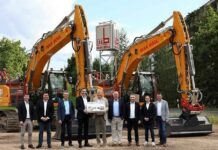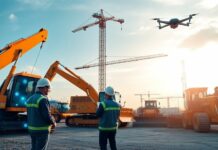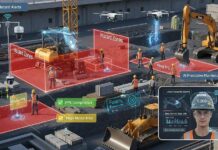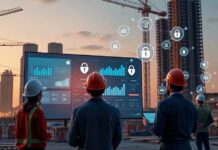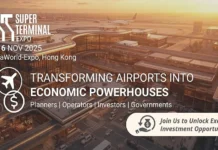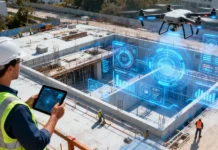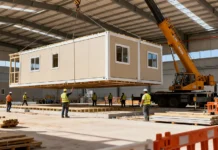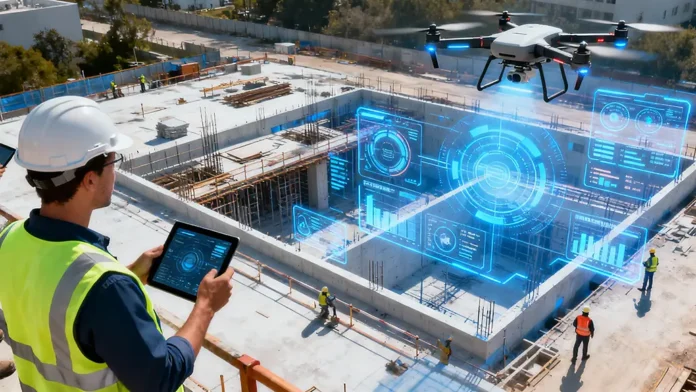The construction industry processes vast quantities of data throughout project lifecycles. Workers generate activity records. Equipment produces operational metrics. Materials flow through supply chains. Environmental conditions fluctuate continuously. Weather patterns evolve. Labor productivity varies. Yet, despite this enormous data availability, construction professionals traditionally managed projects using predominantly manual processes, physical site visits, and delayed reporting. This disconnection between data richness and operational application represents an enormous, missed opportunity for optimization.
Digital twin in construction technology fundamentally bridges this gap by creating dynamic, virtual representations of physical construction assets that evolve continuously as projects develop. These digital replicas—enhanced through Building Information Modeling (BIM), Internet of Things (IoT) sensors, Artificial Intelligence (AI), and real-time data analytics—transform how project managers visualize, monitor, predict, and optimize construction execution. Rather than reacting to problems after they occur, construction leaders armed with digital twin technology and AI in construction proactively anticipate challenges and implement preventive solutions.
The impact extends far beyond incremental efficiency improvements. Projects employing digital twin in construction methodologies achieve 20 percent reductions in simulation-driven planning delays, experience 25 percent reductions in cost overruns, and capture up to 12 percent reductions in rework and waste. These quantifiable benefits across multiple performance dimensions explain why digital twin in construction adoption accelerates rapidly across the construction industry and infrastructure development sectors.
Understanding Digital Twin Technology in Construction Context
A digital twin consists of a sophisticated digital model incorporating complete project specifications, material properties, structural characteristics, systems integration requirements, and real-time operational data. The term “digital twin” emphasizes that this virtual representation genuinely mirrors the physical project—not simply as a static snapshot but as a continuously evolving entity that reflects ongoing changes, accommodates modifications, and incorporates real-time information streams.
Unlike traditional Computer-Aided Design (CAD) models that represent design intent at a specific point in time, digital twins in construction maintain continuous synchronization with physical reality. Sensors deployed throughout construction sites generate streams of positional data, environmental measurements, equipment utilization metrics, and activity records. Machine learning algorithms process these data streams, detect deviations from planned schedules, identify emerging risks, and generate actionable recommendations for project managers.
The Foundation: Building Information Modeling Integration
Building Information Modeling provides the foundational architecture for construction digital twins. A comprehensive BIM model encodes every structural element, mechanical component, electrical system, and spatial relationship within a unified digital environment. This multi-dimensional BIM model captures design intent, material specifications, performance requirements, and spatial constraints with precision unavailable in traditional design documentation.
When enriched with real-time data sources, this BIM foundation becomes a living entity—a digital twin that represents not merely how a building should be constructed but how it is actually being constructed, moment by moment, throughout the project timeline.
Real-Time Data Acquisition Through IoT Integration
The transformation from static BIM model to dynamic digital twin requires continuous data acquisition from construction sites. Internet of Things (IoT) technology enables this continuous monitoring through wireless sensors deployed strategically throughout projects. These sensors measure temperature, humidity, vibration, positioning, equipment status, worker location, material arrival, and dozens of other operational parameters.
Remote sensing technologies including drones equipped with high-resolution cameras and LiDAR systems capture three-dimensional site information. These aerial surveys document progress against scheduled activities, identify material placement, detect safety hazards, and verify compliance with design specifications. Unlike manual inspections requiring workers to physically access potentially hazardous locations, drone-based monitoring provides comprehensive site visibility while minimizing worker exposure to risk.
Artificial Intelligence-Powered Analysis and Prediction
Raw data alone provides limited value without sophisticated analytical capabilities to extract actionable insights. Artificial intelligence algorithms process IoT sensor streams, drone imagery, BIM data, and historical project information to identify patterns, predict outcomes, and recommend actions. These AI capabilities transform data abundance into decision-relevant intelligence.
Machine learning models trained on historical project data develop capability to forecast delays before they occur. By analyzing current conditions against historical patterns, AI systems identify indicators suggesting that specific tasks might fall behind schedule. This early warning enables proactive rescheduling, resource reallocation, or process optimization to prevent delays from materializing.
Design Optimization Through Virtual Simulation
Traditionally, design decisions flow downstream to construction execution with limited opportunity for testing against real-world conditions. Once construction begins, modifications to design become expensive and disruptive. Digital twin technology inverts this workflow by enabling exhaustive virtual testing before physical construction commences.
Enhanced Visualization and Conflict Detection
Construction projects involve complex coordination among architectural, structural, mechanical, electrical, and plumbing systems. These systems must coexist within the same physical space while maintaining required clearances and supporting building functionality. Conflicts between systems—where a structural beam occupies space required for mechanical ductwork, for example—traditionally remained undetected until construction revealed the problem, resulting in expensive field modifications or rework.
Digital twins in construction equipped with intelligent clash detection capabilities identify and resolve these conflicts during design phases before any material procurement occurs. This early conflict identification and resolution eliminate costly field corrections, reduces schedule delays, and ensures that construction can proceed without encountering nasty surprises that derail plans and budgets.
Scenario Simulation and Design Optimization
Digital twin technology enables architects and engineers to test multiple design alternatives virtually against various scenarios before committing to a single solution. How will the building perform during extreme weather events? Will the mechanical system maintain occupant comfort during peak load periods? Can the facility accommodate future expansion requirements? These questions receive answers through virtual simulation rather than through trial-and-error after construction completion.
AI-powered generative design algorithms explore vast design solution spaces far beyond human capability. These algorithms generate optimized solutions balancing multiple competing objectives—structural efficiency, thermal performance, cost, aesthetics, and sustainability—to identify solutions that might never emerge from traditional design processes.
Real-Time Project Monitoring and Control
Construction execution proceeds through hundreds or thousands of interconnected tasks. Coordination complexity grows exponentially with project size and complexity. Material deliveries must synchronize with labor availability. Equipment must be deployed at the precise moment required. Workers must follow sequences preventing conflicts and ensuring safety. Traditional management approaches struggle to coordinate this complexity effectively. Digital twins combined with AI in construction enable real-time visibility and adaptive control of project execution.
Progress Tracking Against Scheduled Plans
Digital twins in construction provide continuous visibility into actual progress against planned schedules. Drone imagery and sensor data automatically update digital models to reflect current site conditions. Machine learning algorithms compare actual progress against planned activities, detecting deviations rapidly.
When a task completes ahead of schedule, the system identifies successor tasks that can commence immediately, compressing overall timelines. When a task falls behind, the system analyzes consequences, identifies critical path impacts, and recommends mitigation strategies. This real-time responsiveness enables construction managers to optimize schedule execution continuously rather than discovering schedule problems at monthly reporting intervals after opportunities for intervention have passed.
Resource Optimization and Utilization
Construction labor, equipment, and material represent substantial project investments. Inefficient utilization of these resources directly increases project costs. Digital twin systems monitor resource utilization in real-time, identifying and eliminating idle periods. When equipment sits unused, the system identifies alternative valuable activities. When workers experience idle time, the system reschedules tasks to maintain continuous productive engagement.
Crossrail, the largest infrastructure project in Europe, exemplifies these optimization capabilities. The 73-mile railway corridor connecting 41 stations required coordination of over 10,000 workers representing multiple disciplines across dozens of locations. A digital twin system called “Virtual Railway” integrated data from three-dimensional BIM models, asset information, and continuous construction updates. This virtual representation enabled real-time collaboration across the dispersed workforce, ensuring that all teams operated from current information and coordinated decisions seamlessly. The enhanced coordination visibility enabled by the digital twin allowed Crossrail to optimize resource deployment and schedule execution across the project’s enormous complexity.
Risk Anticipation and Mitigation Strategy
Construction projects inherently involve uncertainty. Weather patterns change unpredictably. Supply chains experience disruptions. Workers require unplanned absences. Material quality sometimes fails inspection. Equipment malfunctions. Changes in site conditions emerge unexpectedly. Traditional project management approaches wait for these risks to materialize before responding. Digital twins combined with predictive analytics enable proactive risk management through anticipation.
Predictive Analytics for Schedule Risk Identification
Historical project data reveals patterns associated with schedule delays. Specific task types, particular weather conditions, certain supply chains, and specific labor configurations generate observable risk indicators. Machine learning models trained on this historical data develop capability to identify when current conditions match historical patterns preceding delays.
When such patterns emerge in current projects, the system alerts project managers, enabling intervention before delays solidify. Additional resources can be allocated preemptively. Task sequencing can be adjusted. Contingency activities can commence. This proactive intervention prevents delays from occurring rather than attempting mitigation after delays become inevitable.
Supply Chain Risk Management
Supply chain disruptions represent significant construction risk. Material delays create cascading schedule impacts. Quality issues require rework and additional costs. Supplier failures necessitate emergency procurement at premium costs. Digital twin systems integrated with supply chain data provide visibility into material flows and inventory status.
When supply chain indicators suggest potential disruptions, the system alerts procurement professionals enabling preventive action. Alternative suppliers can be contacted. Production schedules can be adjusted. Advanced material ordering can commence. These proactive interventions maintain supply chain continuity and prevent schedule disruptions.
Environmental and Site Condition Forecasting
Weather represents a primary source of construction delays and safety incidents. Weather forecasts provide predictions days or weeks in advance. Digital twin systems integrate weather predictions with project requirements to identify potential conflicts. When significant weather events approach, the system identifies vulnerable activities and recommends protective measures or schedule adjustments.
Similarly, site conditions evolve as excavation proceeds and environmental factors interact. Groundwater levels fluctuate. Soil characteristics change. Unforeseen underground utilities emerge. Digital twin systems incorporating sensor data about site conditions enable prediction of soil behavior and ground stability issues before excavation encounters problems.
Enhanced Collaboration and Stakeholder Communication
Construction projects involve numerous stakeholders including owners, architects, engineers, contractors, subcontractors, equipment suppliers, and regulatory agencies. These stakeholders maintain diverse interests and priorities, creating communication challenges that frequently generate misunderstandings and coordination failures.
Unified Information Repository
Digital twins in construction serve as unified information repositories accessible to all authorized stakeholders. Rather than stakeholders maintaining separate documents and information sources with inevitable inconsistencies and version control problems, the digital twin provides a single authoritative source of current project information.
Architects, engineers, and contractors access the same current models. Discrepancies between their understanding of project status disappear. When design modifications occur, all stakeholders immediately understand implications. When construction sequences change, everyone recognizes schedule impacts. This unified visibility eliminates costly miscommunications and coordination failures.
Immersive Virtual Visualization
Stakeholders interact with digital twins through various visualization technologies from traditional 2D computer displays to immersive virtual reality environments. Virtual reality visualization enables stakeholders to “walk through” completed projects before construction commences, experiencing spatial relationships and design intent in ways impossible from traditional plans and renderings.
Owners can verify that design decisions align with their requirements before expensive material procurement. Contractors can optimize construction sequences by analyzing project layouts three-dimensionally. Subcontractors can verify compatibility of their systems with other building components. These virtual explorations reduce surprises during construction and improve decision quality.
Facility Management and Lifecycle Optimization
Digital twins provide value extending well beyond construction phases into facility operations spanning decades. Buildings complete construction only to begin decades of operation, maintenance, and evolution. Lifecycle costs for building operations frequently exceed construction costs by multiples. Digital twins capable of monitoring operational performance throughout building lifecycles enable significant long-term value realization.
Continuous Performance Monitoring
Digital twins continued operation throughout building lifecycles monitor equipment performance, energy consumption, occupant behavior, environmental conditions, and system interactions. This continuous monitoring generates data revealing how buildings actually perform versus design assumptions. HVAC systems efficiency, lighting performance, water usage, occupancy patterns—all become visible through continuous monitoring.
When equipment performance degrades, sensors detect the degradation before failures occur. Maintenance can be performed proactively during planned intervals rather than reactively after catastrophic failures. Building systems requiring energy optimization become visible through consumption monitoring. Occupancy patterns can inform space utilization strategies.
Predictive Maintenance and System Health Management
Equipment failures disrupt building operations, compromise occupant comfort, and generate emergency repair expenses. Digital twins monitor equipment continuously, developing profiles of normal operation. When equipment behavior deviates from normal patterns, the system alerts maintenance personnel enabling intervention before failures occur.
Bearing vibration patterns change subtly as bearings degrade. Temperature trends shift slightly as systems age. Electrical consumption patterns evolve. These subtle signals, detected through continuous monitoring and analyzed by machine learning algorithms, provide early warnings of impending failures. Maintenance can occur during scheduled intervals rather than emergency response following failures.
Future Evolution and Emerging Capabilities
Digital twin technology continues evolving rapidly through integration of emerging technologies and expanding analytical capabilities. Artificial intelligence becomes more sophisticated. Computing capabilities expand. Sensor technology becomes more capable and affordable. These technological advances enable ever-more-comprehensive and predictive digital twins.
Integration with Augmented and Virtual Reality
Emerging applications integrate digital twins with augmented reality (AR) and virtual reality (VR) technologies enabling workers to visualize digital information overlaid on physical reality. Workers equipped with AR-capable headsets see digital models overlaid on physical construction sites, displaying planned positions of components, highlighting safety hazards, and providing step-by-step instructions for assembly tasks.
These immersive visualizations reduce interpretation errors, improve worker safety, and accelerate task execution. Workers no longer require translation from abstract plans to physical reality—digital information appears directly within their visual field, fully registered to physical locations.
Advanced Robotics Integration
Autonomous construction robots performing repetitive tasks represent another emerging capability. These robots access digital twin information to understand their required tasks, optimal tool deployment, and coordination with other activities. Construction sites gradually transition from labor-intensive manual assembly toward automated systems performing tasks with superior precision and consistency.
Blockchain for Governance and Transparency
Blockchain technology enables immutable recording of construction decisions, quality inspections, safety observations, and contract compliance milestones. Digital twins integrated with blockchain create transparent governance frameworks preventing disputes and establishing clear accountability. When questions arise about whether specific work requirements were satisfied, blockchain records provide definitive documentation.
Implementation Strategies and Organizational Readiness
Successful digital twin deployment requires more than technology acquisition. Organizations must develop capabilities in data management, analytical interpretation, process adaptation, and human factors. Rushing implementation without organizational readiness generates disappointing results.
Phased Implementation Approach
Organizations should consider phased implementation beginning with pilot projects demonstrating business value before enterprise-wide rollout. Early pilots should focus on specific challenges—schedule optimization, quality improvement, or safety enhancement—rather than attempting comprehensive transformation immediately.
Pilot successes build internal expertise, demonstrate return on investment, and create enthusiasm supporting broader adoption. Lessons learned in pilot projects can be applied to subsequent implementations, progressively expanding capabilities.
Workforce Development and Digital Literacy
Digital twin technology requires workforce capabilities far beyond traditional construction knowledge. Data interpretation, analytical thinking, technology operation, and digital literacy become essential. Organizations should invest in workforce development enabling personnel to operate within digital environments effectively. Technology providers should partner with construction organizations to provide training and support enabling successful adoption.
Conclusion: The Intelligence Revolution in Construction
Digital twins combined with AI in construction and smart construction practices represent a fundamental transformation in how the construction industry operates. Rather than reactive management responding to problems after emergence, construction professionals armed with digital twin technology manage projects proactively, anticipating challenges and implementing preventive solutions.
The evidence from successful deployments worldwide demonstrates that digital twins in construction deliver promised benefits reliably across diverse project types and contexts. Projects employing these technologies consistently outperform comparable traditional projects across schedule, cost, quality, and safety dimensions.
As technology continues evolving and industry practices adapt to leverage emerging capabilities, the gap between organizations embracing digital twin technology and those relying on traditional approaches will widen progressively. The construction industry stands at an inflection point where embracing digital twin in construction methodologies transitions from competitive advantage to competitive necessity. Organizations leading this transformation position themselves to capture substantial advantages in an evolving marketplace increasingly demanding intelligent, efficient, and data-driven construction delivery.







